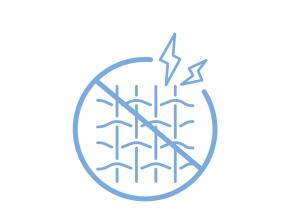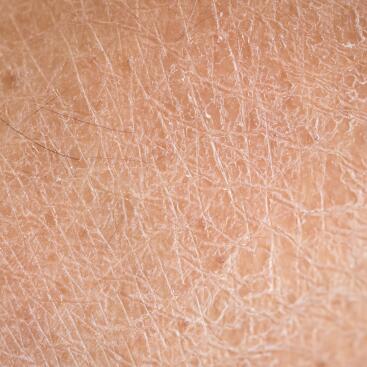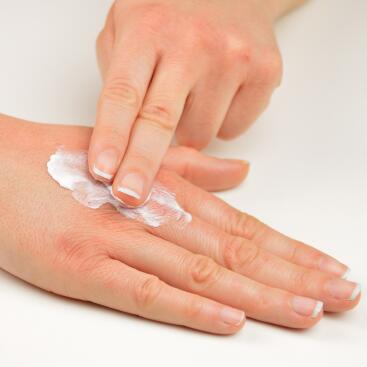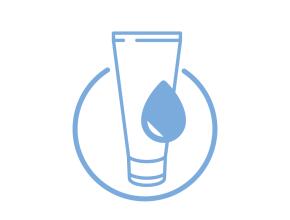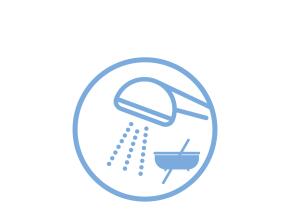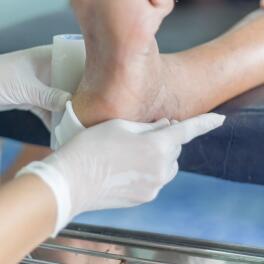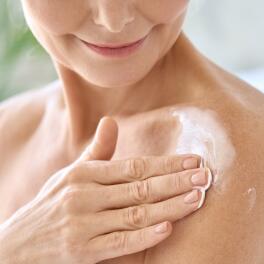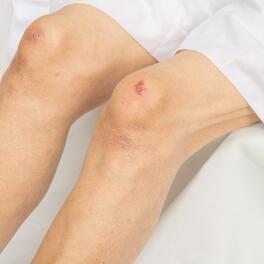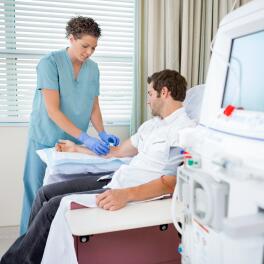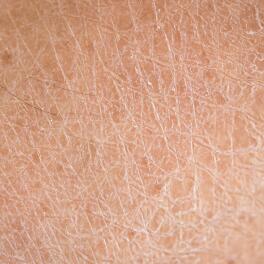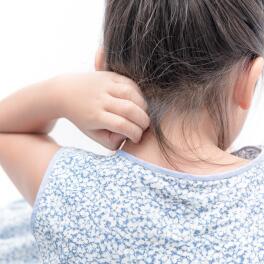Xerosis: causes, symptoms and treatments
Xerosis is the scientific term for dry skin. It is accompanied by other symptoms such as mild to significant shedding, fragile skin and thinning of the skin1. It is estimated that one in three people suffer from dry skin and that the frequency increases with age, affecting up to 75% of the elderly2. But what causes xerosis? What are the different forms? How can you relieve symptoms?
- 33
of people suffer from dry skin
- 75
of the elderly suffer from dry skin

Summary
What is xerosis and what are its symptoms?
Xerosis is defined as a state of dryness of the skin3,4. Clinically, it manifests itself as rough skin, that feels coarse to the touch. It is accompanied by discomfort, tightness and sometimes itching. In the case of dry skin, the skin folds are more affected and scales (like large dandruff) may appear accompanied by redness or even cracks5. When itching is severe, scratch lesions can become infected and leave a locally thickened skin called lichenification. This thickening is more likely to occur when the scratching is chronic.
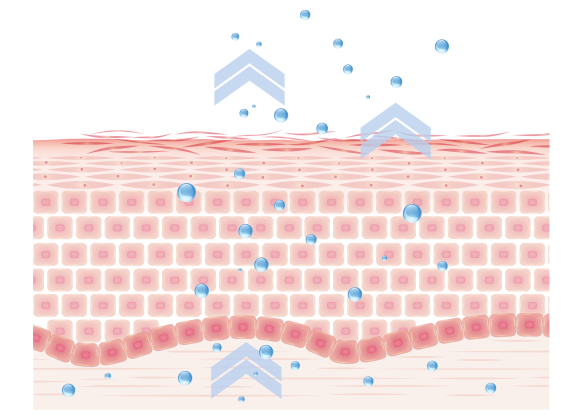
With xerosis, the structure of the stratum corneum, i.e. the superficial layer of the epidermis, is altered and the following can be observed6 :
- Keratinisation disorders6. This refers to the production and build-up of keratin in the stratum corneum7. This acts as a barrier to protect the skin from external aggressors8
- A decrease in the production of skin surface lipids. The sebaceous glands in the dermis produce fatty acids that make up sebum. The combination of sebum and sweat (produced by the sweat glands) forms a protective film called the hydrolipidic film. Its purpose is to maintain the skin's moisture content. With xerosis, this protective film is defective to a greater or lesser extent.
- Skin that is more acidic than normal. This is determined by measuring the pH: the pH of normal skin is 6.5, which is the physiological pH. PH values below 6.5 are measured on skin with xerosis9.
What causes xerosis?
The main cause of xerosis is age. In fact, the older we get, the drier the skin becomes. Due to the decrease in sex hormone levels with age, the activity of the sebaceous and sweat glands decreases as we get older. This physiological phenomenon is all the more marked in women after menopause.
Other factors associated with dry skin:
- The sun dries out the skin
- Climate: low temperatures and dry weather increase skin dehydration. The same applies to prolonged use of air conditioning
- Hard water
- Unsuitable clothing (too tight, irritating fabrics, etc.) that causes chafing
- Excessive body hygiene: repeated hot showers or baths and the use of unsuitable hygiene products alter the hydrolipidic film. The skin is no longer able to renew itself properly
- Irritating products such as detergents or cleaning products can cause xerosis on the hands
- Variations in sex hormone levels (puberty, pregnancy, menopause, etc.)
- A diet low in essential fatty acids and zinc, which are essential for good skin health
OUR TIPS FOR MINIMISING XEROSIS:
Wear appropriate clothing
Beware of excessive hygiene
Conditions and treatments that can cause xerosis problems
- Atopic dermatitis
- Ichthyosis
- The use of skin treatments
- Conditions can also cause xerosis. This is mainly the case for dermatological conditions such as psoriasis, eczema, atopic dermatitis and ichthyosis. Other disorders such as diabetes or hypothyroidism can also explain abnormally dry skin
- Finally, some medicines can cause xerosis: this is the case, for example, for local skin treatments containing high concentrations of alcohol, some diuretics that can cause dehydration of the body, some acne treatments or some cancer treatments.
What are the different origins of xerosis?
Depending on the cause of the xerosis, a distinction can be made between various forms10 :
- Winter xerosis: is a form of xerosis whose symptoms are aggravated by climatic conditions (cold and dry weather, wind, etc.)
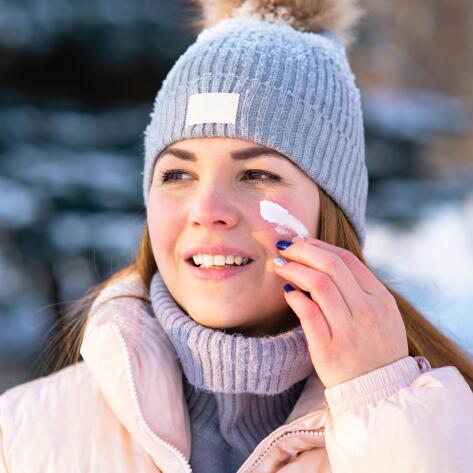
Senile xerosis : is physiological, it appears with age and often affects the limbs more
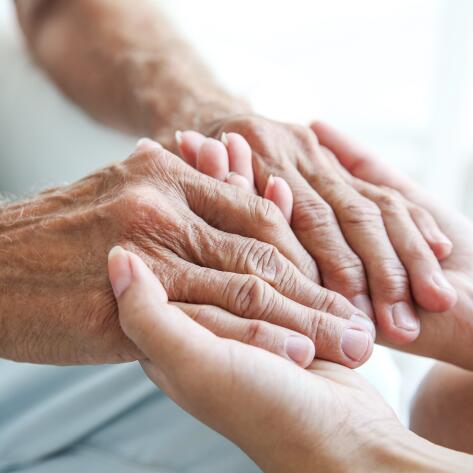
Induced xerosis: this is a side effect of using local treatments that dehydrate the skin, such as hygiene products that are not suitable for the skin and/or are too aggressive, or irritating local treatments such as retinoid-based creams prescribed, in particular, for treating acne, psoriasis or some forms of severe eczema11. Systemic treatments , especially cancer treatments, can cause xerosis.
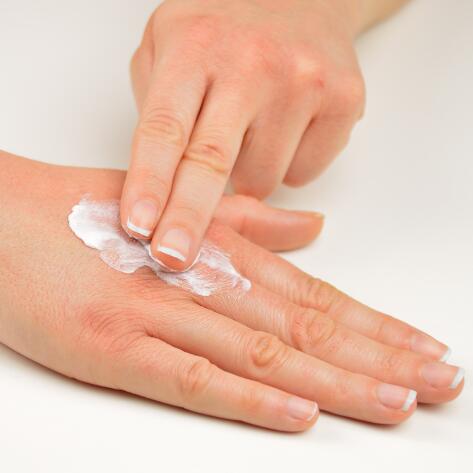
Xerosis associated with another condition such as atopic eczema or ichthyosis. Dry skin is one of the symptoms.

Xerosis is also a common symptom in patients with type 1 or 2 diabetes and can lead to complications such as diabetic foot12.
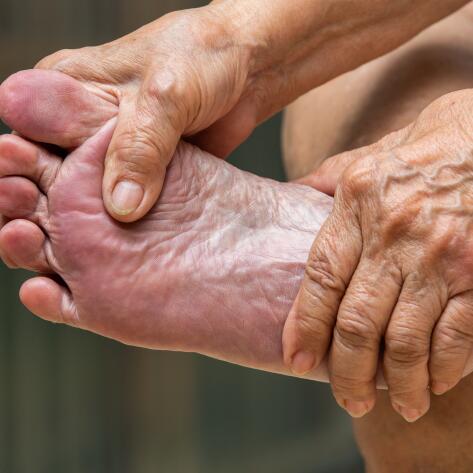
How do you take care of your skin with xerosis?
Adapt personal hygiene products
Make sure your skin is well hydrated
Choose showers over baths
Simple measures can be taken to minimise the symptoms of xerosis 13,14,15:
- The most important thing is to ensure that your skin is properly moisturised at least once a day. It is important to get into the habit of moisturising the skin at least after every bath or shower. Pay particular attention to the thighs, legs and waist, where clothes rub and irritate the skin. Favour emollient products specially adapted to dry, sensitive or even atopic skin. They are hypoallergenic and formulated without allergenic ingredients, fragrance or parabens
- You should also adapt your personal hygiene products: use ultra-rich products, without soap and enriched with nourishing substances. Again, favour products formulated without fragrance, parabens or irritants. You can get hygiene products adapted to dry and/or sensitive skin
- Opt for showers over baths as they don't take as long and alter the hydrolipidic film less
- Use lukewarm water, which is less aggressive for the skin
- Rinse without fail after swimming in the sea or a pool to remove salt and chlorine, which can make dry skin worse
- With xerosis on the hands, wear gloves when handling irritating products (e.g. for washing dishes or cleaning)
- Humidify the air in the room and avoid overuse of air conditioning to combat skin dryness
- Avoid sun abuse: apply a sunscreen with SPF 50+ and avoid exposure between 10 am and 4 pm, when the sun is at its highest
- Good skin hydration starts with sufficient water intake: drinking at least one and a half litres of water per day, or even more in the event of hot weather or heavy exercise is recommended.
Are you familiar with the effectiveness of DEXERYL in treating your condition?
DEXERYL provides patients with proven clinical studies.
DEXERYL: the skin partner for dry and sensitive skin
The basis for treating xerosis is, above all, moisturising the skin and appropriate hygiene.
DEXERYL supports you with emollient skin care and cleansers specially formulated for sensitive skin and recommended for the treatment of signs of skin dryness (xerosis).

DEXERYL Emollient Cream
Dexeryl Emollient Cream can be used to protect the skin and treat the signs and symptoms of dry skin, particularly in the context of xerosis.

Dexeryl supports you each day
Sources:
- https://www.healthline.com/health/xerosis
- Cristaudo, L Francesconi et al. : Efficacy of an emollient dermoprotective cream in the treatment of elderly skin affected by xerosis; Giornale Italiano di Dermatologica e Venereologia 2015; 150: 297-302
- https://www.uspharmacist.com/article/xerosis-treating-clinically-dry-skin
- https://www.mountsinai.org/health-library/diseases-conditions/xerosis
- https://www.vidal.fr/maladies/peau-cheveux-ongles/secheresse-peau-ongles.html
- https://www.lissa.fr/rep/articles/11976541
- https://www.larousse.fr/dictionnaires/francais/kératinisation/45429
- https://www.lissa.fr/rep/articles/EL_S0246031910504072
- https://www.peau.net/problemes/abc/ph-peau/
- https://www.verywellhealth.com/xerosis-4707735
- https://pharmacomedicale.org/medicaments/par-specialites/item/retinoides
- https://www.ncbi.nlm.nih.gov/pmc/articles/PMC5006568/
- https://www.vidal.fr/maladies/peau-cheveux-ongles/secheresse-peau-ongles/prevention.htm
- https://www.vidal.fr/maladies/peau-cheveux-ongles/secheresse-peau-ongles/traitements.html
- https://www.healthline.com/health/xerosis#prevention


